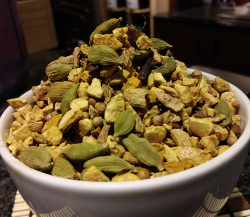Tea & Ayurveda: A Gleaning

Tea & Ayurveda: A Gleaning
If you have come into the tea shop and looked at the wall behind the counter, you will notice a color-coded array of boxes containing the yearly catalog of our tea collection. Perhaps you have heard us explaining it?
“Green boxes are green teas, blues are white teas…and orange are our ayurvedic/spiced preparations.”
The question I hear most often following is:
“What is Ayurveda?”
To be honest, I struggle to tell you because this question is broad and my experience with it is not. Ayurveda is difficult to describe in a user-friendly sound bite. With a rich history spanning over 5000 years of oral lineage, ayurveda is a holistic wellness practice that focuses on preventive health care through the balancing of systems of energetic aspects, known as doshas or constitutions. For those who have heard of them, the doshic names of our ayurvedic preparations will be familiar–Kapha, Vata, and Pitta. It is believed that we have all three present in some fashion, but one or two that provide our overall makeup. Ayurvedic principles believe that the source of illnesses generally points to a deficiency or imbalance between these doshas, and primary constitution can be identified by analysis of physical characteristics, personality traits, dietary habits, and overall behavioral patterns. It is through the mindful regulations of those systems that we maintain doshic balance and overall well being.
[You can take your dosha quiz through Yoga International here, if you’re interested.]
“Vata is the energy of movement, pitta is the energy of digestion or metabolism and kapha, the energy of lubrication and structure.” 2
Yoga international takes it a step further and more simply:
Vata
Is often referred to as the vayu (wind) in the body…is responsible for our mental and physical adaptability…and it governs our nervous system, our bones, and our senses of touch and hearing.3 Vata is thought to be comprised of earth and water. The systems stimulated by vata are those that signal our bodies movement impulses, and keep up moving once we are going.
Kapha
Is the dosha responsible for the stability, lubrication, substance, and support of our physical body. Kapha supports our mental and physical endurance, and it allows us to feel deeply, to empathize, and to be patient and compassionate.4 Kapha is made of Earth and Water, and a healthy balance of it allows the fluids and liquids of our bodies to flow effortlessly, supporting our joints in a way the provides us with strength and flexibility, keeping us grounded in our truth and stably connected to the earth.
Pitta
Is the dosha responsible for our ability to mentally digest our life experiences and biologically digest our food. Pitta is responsible for all of our chemical and metabolic transformations. 5 Pitta is made of fire and air. The systems governed by pitta allow us to assimilate new information and energy from the outside, and power our internal drive/fire. When we are feeling unmotivated, it is usually because our pitta is struggling at the embers.
If you think of these three aspects as flames which burn at different strengths and heights, you can see how the things we consume figuratively fuel our doshas. The doshic preparations that we offer are based on dietary ayurvedic principles to help keep these qualities in balance with the rest. I (with a limited understanding of ayurveda) often suggest that guests sniff all three to see which their senses like the most or guide them toward, using the basic principle that we are the best judges of our own need.
The Tin Roof Tea’s Vata tea blend, with cardamom, ginger, licorice, orange peel, and cinnamon is a great blend to revitalize and warm oneself, helping us get back into motion when we’ve slowed down.6a
The Kapha blend is a spicy blend with turmeric and pepper to help encourage the flow of kaphas lubricating structures.6b
The Pitta blend with rose and coriander taps into the pittas betterment with bitter and sour pacifying foods, which help stimulate the digestive juices and get our internal engines ready for proper combustion.6c
I find that if I’m feeling out of sorts, I’ll take a whiff and see what suits my fancy for the day. Lately, I’ve been enjoying iced cups of our fourth ayurvedic variety, the Feng-Shui herbal blend. Something about the light and refreshing blend of lemongrass, and orange peel countered by the pungent and bitter qualities of nettle and marigold blossom gets me jazzed. It’s good hot or iced; most especially at room temperature when I get a second to sip at my cuppa during the workday. A pump or two of our wildflower honey syrup from the Tea Bar and I’m ready to rumble, tackling your inquiries and demands one by one! Come give these blends a smell, and see what doshic dynamism may need some yoking.
Hopefully from this, you have had one of your questions of greatest breadth given some depth and refinement.
Until Then,
Peace Within
Sources:
1,2 From: Ayurveda: A Brief Introduction and Guide by Vasant Lad, B.A.M.S., M.A.Sc. https://www.ayurveda.com/pdf/intro_ayurveda.pdf
3 From: About Vata by Kathryn Templeton
https://yogainternational.com/article/view/about-vata
4 From: About Kapha by Kathryn Templeton
https://yogainternational.com/article/view/about-kapha/
5 From: About Pitta by Kathryn Templeton
https://yogainternational.com/article/view/about-pitta/
6 a, b, c From [Pitta, Kapha, Vata] Diet: Everything You Need to Know
Pitta Kapha Vata

